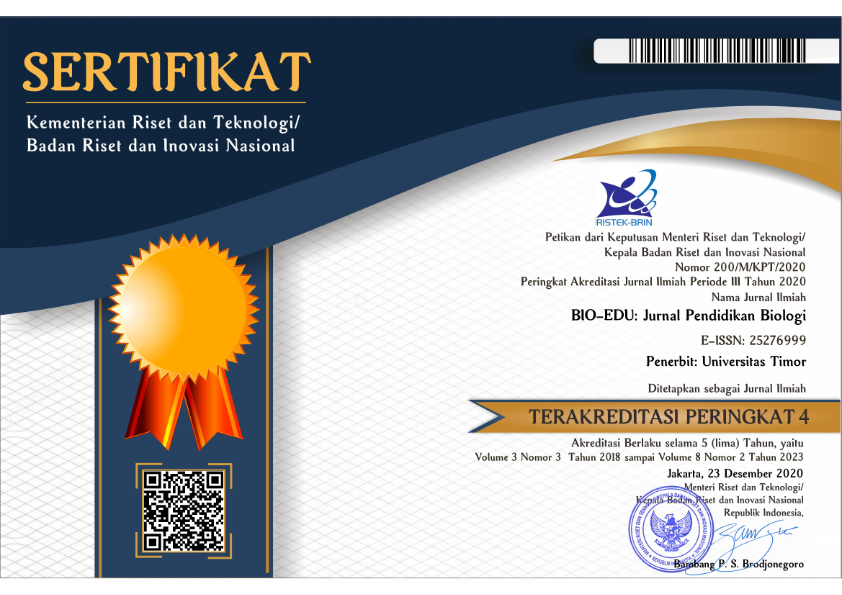Penggunaan Media Pembelajaran Berbasis E-Learning Terhadap Motivasi Belajar Biologi Siswa
DOI:
https://doi.org/10.32938/jbe.v6i3.1352Keywords:
Biology, E-Learning, Learning Media, Student’s MotivationAbstract
One of the main problems in learning biology is the lack of student motivation in learning. This is partly due to the lack of learning media that can visualize learning more exciting and easily understood by students without multiple interpretations due to not seeing the real learning object. Therefore, this study was conducted to determine the types or variants of e-learning media in biology learning and analyze the background problems based on previous studies of previous studies. The method used in this research is a literature study with a pure research style. The data collection technique is a library research technique with data sources in reference books and 37 articles relevant to research topics in the period 2013 to 2020. Data analysis is carried out using content analysis and exploration models, where the analysis results are used as a basis for interpretation. Based on the discussion that has been done, it can be concluded that this study found 15 types of e-learning media in biology learning that can increase student learning motivation, where the most influential media are android applications, interactive multimedia, animation, and original el-learning. In addition, it was also found that the background that caused the students' low motivation to learn was due to the lack of technology development in biology learning media, the lack of visualization of various objects of biology learning, and the lack of student interest in participating in biology learning.
References
Cimer, A. (2012). What Makes Biology Learning Difficult and Effective : Students' Views. Educational research and Reviews, 61-71.
Darmawan, D. (2018). Teknologi Pembelajaran. Bandung: Remaja Rosdakarya.
Daud, F., & Rahmadana, A. (2015). Development of Biology Instructional Media Based E-learning for Excretion System Concepts at Class XI IPA3 SMAN 4 Makassar. Bionature Journal
Fadhilah, R. E. (2017). The Development of Scientific Approach-Based Interactive Learning Media of Biology on the Topic of Auditory System for High School Students. International Journal of Humanities Social Sciences and Education (IJHSSE), 127-133.
Gall, M. D. (2003). Educational Research An Introduction Seventh Edition. USA: Pearson Education, Inc.
Hirumi, A. (2014). Bermain Game di Sekolah : Video Game dan Permainan Komputer Simulasi untuk Anak SD dan SMP. Jakarta: Penerbit Indeks.
Indrastyawati, C., Paidi, P., & Ciptono, C. (2016). Development of Sensory System Learning Media Based on Android to Improve Motivation and Learning Outcomes Students. Biology Education Journal, 5(7), 50-56.
Jeno, L. M. (2019). The effects of m-learning on motivation, achievement and well-being: A Self-Determination Theory approach. British Journal of Educational Technology, 669-683.
Kurniawan, A. D. (2018). Developing Flash Media of Quranic-Based Human Reproduction System Material. JPBI (Jurnal Pendidikan Biologi Indonesia), 235-242.
Libao, N. d. (2013). Science Learning Motivation as Correlate of Students' Academic Performances. Journal of Technology and Science Education, 209-218.
Monemi, R. L. (2017). Pengembangan Multimedia Interaktif Berbasis Power Point Disertai Game Kuis Course Maze pada Materi Sistem Ekskresi untuk Peserta Didik Kelas VIII SMP. Berkala Ilmiah Bidang Biologi, 252-262.
Mukti, I. N & Cahyo. (2017). Pengembangan Media Pembelajaran Biologi Berbantuan Komputer untuk Meningkatkan Hasil Belajar Peserta Didik. Jurnal Inovasi Pendidikan IPA, 137-149.
Muyaroah, S., & Fajartia, M. (2017). Develompent Android Media Learning using Adobe Flash CS 6 Aplication in Biology Subject. Innovative Journal of Curriculum and Educational Technology, 6(2), 79-83.
Nugroho, L. H. (2004). Biologi Dasar. Depok: Penebar Swadaya.
Pannen, P. M. (2001). Konstruktivisme dalam Pembelajaran. Jakarta: Penerbit Universitas Terbuka.
Pranasiwi, O. S. (2015). Pengembangan Aplikasi Kunci Determinasi Berbasis Android Pokok Bahasan Mamalia di SMA/MA. Artikel Ilmiah Mahasiswa, 1-7.
Pribadi, B. A. (2017). Media dan Teknologi dalam Pembelajaran. Jakarta: Kencana - Prenadamedia Group.
Primasari, R. d. (2014). Penggunaan Media Pembelajaran di Madrasah Aliah Negeri Se-Jakarta Selatan. Edusains, 68-72.
Purba, A., Sipahutar, H., & Edi, S. (2017). Comparison of Motivation and Student s ’ Learning Achievements by using E-Learning based Schoology and Power Point on Biology Material. 4(11), 208–213.
Qumilaila, Q., Susanti, B. H., & Zulfiani, Z. (2017). Pengembangan Augmented Reality Versi Android Sebagai Media Pembelajaran Sistem Ekskresi Manusia. Jurnal Cakrawala Pendidikan, 36(1), 57-69.
Safira, I. I. (2018). Pengembangan Media Pembelajaran Biologi Berbasis Web pada Konsep Sistem Pencernaan di Sekolah Menengah Atas. UNM Journal of Biological Education, 111-125.
Sari, A. M. (2018). Improving Students Learning Motivation Through Mobile Learning. JPBI (Jurnal Pendidikan Biologi Indonesia), 271-276.
Sudjana, N. d. (2011). Media Pengajaran. Bandung: Sinar Baru Algesindo.
Tamumu, R. M. (2017). Keterkaitan Metode dan Media Bervariasi dengan Minat Siswa dalam Pembelajaran Biologi Tingkat SMP. Jurnal Pendidikan, 134-142.
Tsui, C., Treagust, D., Tsui, C., & Treagust, D. (2010). Learning genetics with computer dragons. October 2014. https://doi.org/10.1080/00219266.2003.9655859
Widiasworo, E. (2019). 19 Kiat Sukses Membangkitkan Motivasi Belajar Peserta Didik. Yogyakarta: Ar-Ruzz Media.
Yüzbaşılıoğlu A, A. E. (2004). Determining students’ learning level of daily life biology subjects. Hacettepe Univ. J. Educ, 276-285.
Zed, M. (2003). Metode Penelitian Kepustakaan. Jakarta: Yayasan Obor Indonesia.
Zaharah, Z., & Susilowati, A. (2020). Meningkatkan Motivasi Belajar Peserta Didik Dengan Menggunakan Media Modul Elektronik Di Era Revolusi Industri 4.0. Biodik, 6(2), 39–52. https://doi.org/10.22437/bio.v6i2.8950.
Downloads
Published
Issue
Section
License
The Authors submitting a manuscript do so on the understanding that if accepted for publication, the copyright of the article shall be assigned to BIO-EDU: Jurnal Pendidikan Biologi and Departement of Biology Education, Universitas Timor as the publisher of the journal. Copyright encompasses rights to reproduce and deliver the article in all form and media, including reprints, photographs, microfilms, and any other similar reproductions, as well as translations.
BIO-EDU journal and Departement Biology Education, Universitas Timor, and the Editors make every effort to ensure that no wrong or misleading data, opinions, or statements be published in the journal. In any way, the contents of the articles and advertisements published in BIO-EDU are the sole and responsibility of their respective authors and advertisers.
Users of this website will be licensed to use materials from this website following the Creative Commons Attribution-ShareAlike 4.0 International License.



















